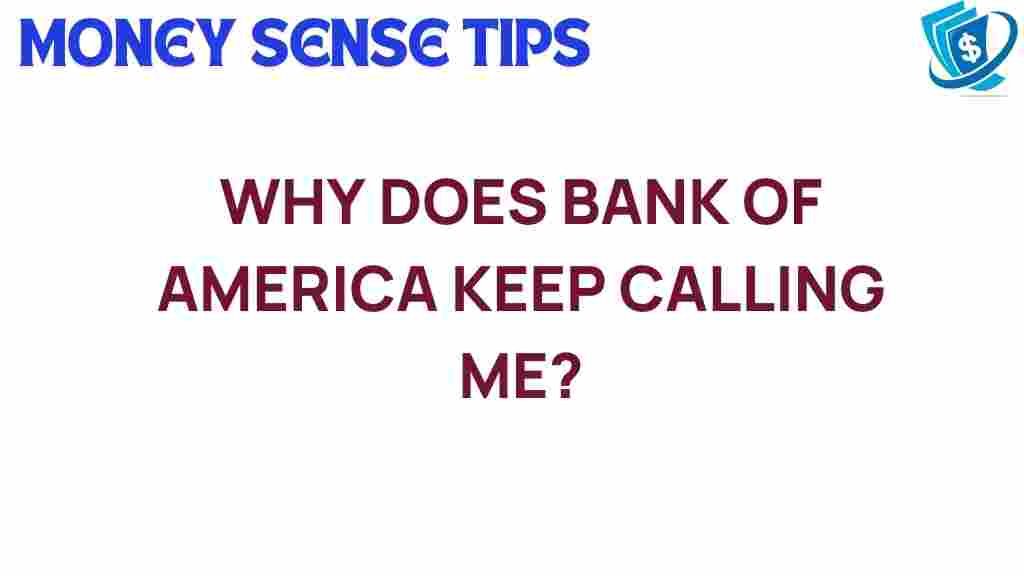The Mystery Behind Bank of America’s Persistent Calls: What You Need to Know
In recent years, many customers have reported receiving unsolicited calls from Bank of America, raising eyebrows and concerns about privacy and banking practices. Understanding why these calls happen, their frequency, and how customers can protect their rights is crucial in today’s world of finance. This article delves into the mystery behind these persistent calls, addressing consumer rights, privacy concerns, and what you can do if you find yourself on the receiving end of these communications.
Understanding Bank of America’s Customer Service Approach
As one of the leading financial institutions in the United States, Bank of America prides itself on providing excellent customer service. However, this commitment sometimes translates into frequent outreach to customers. Here are some reasons why you might receive unsolicited calls:
- Account Notifications: Bank of America may call to inform you about important updates regarding your account, such as suspicious activities or changes in your service.
- Payment Reminders: If you have an outstanding balance, you might receive calls reminding you to make a payment.
- Promotional Offers: The bank often reaches out to inform customers about new products or services that might interest them.
- Customer Feedback: Occasionally, they may call to gather feedback on customer satisfaction and service quality.
The Call Frequency: How Often Should You Expect to Hear from Them?
Understanding the frequency of these unsolicited calls can help you gauge whether the communication is normal or excessive. Here are some insights into call frequency:
- Regular Updates: Customers may receive calls every few months for account updates or promotional offers.
- Increased Frequency in Specific Cases: If there are issues with your account, such as overdue payments, calls may become more frequent.
- Opt-Out Options: Customers can often reduce call frequency by opting out of promotional communications.
Privacy Concerns: Are Your Details Safe?
One of the major concerns regarding unsolicited calls is the potential breach of privacy. Customers often worry about how their information is obtained and used. Here are some points to consider:
- Data Sharing: Understand that banks sometimes share information with third-party vendors for marketing purposes, which can lead to unsolicited calls.
- Telemarketing Regulations: Financial institutions must follow strict regulations regarding telemarketing. If you’re on the National Do Not Call Registry, you should not receive unsolicited calls.
- Phishing Risks: Be cautious; always verify that the call is legitimate. Scammers often impersonate banks to gain personal information.
Consumer Rights: What You Should Know
As a consumer, knowing your rights can empower you when dealing with unsolicited calls from Bank of America or any other financial institution. Here are your key rights:
- Right to Opt-Out: You have the right to request that your number be removed from their call list.
- Right to Information: If you receive a call, you can ask for details to confirm the legitimacy of the call.
- Right to Report: If you feel harassed or if the calls are excessive, you can report them to the Federal Trade Commission (FTC).
Banking Practices: How to Handle Unsolicited Calls
If you receive an unsolicited call from Bank of America, follow these steps to handle the situation effectively:
- Verify the Caller: Always ask for the caller’s name and department. You can also hang up and call back using the official number found on the Bank of America website.
- Do Not Share Personal Information: Never provide sensitive information over the phone unless you are sure about the caller’s identity.
- Document the Call: Keep a record of the call, including the date, time, and content of the conversation.
- Opt-Out: If you want to stop receiving calls, ask the representative how to opt-out from future communications.
- Report Suspicious Activity: If you suspect fraud, report it to Bank of America immediately and monitor your accounts closely.
Troubleshooting Tips for Unwanted Calls
If you find that you are receiving more calls than you are comfortable with, consider these troubleshooting tips:
- Register on the National Do Not Call Registry: This can help reduce unsolicited calls from various telemarketers.
- Use Call Blocking Features: Many smartphones have built-in features to block unwanted numbers.
- Report Harassment: If calls are excessively frequent, report them to the FTC or your state’s consumer protection agency.
- Communicate with Bank of America: Directly reach out to their customer service to express your concerns about call frequency.
The unsolicited calls from Bank of America can be a source of annoyance and concern for many customers. Understanding the reasons behind these calls, your rights as a consumer, and how to manage these communications can help ease your worries. By staying informed and proactive, you can navigate the complexities of banking practices while protecting your privacy. If you have any further questions or need assistance, consider reaching out to Bank of America customer service for more information.
Ultimately, being vigilant and informed is your best defense against unwanted calls and ensuring your financial safety in a world filled with unsolicited communications.
For more tips on managing your finances and understanding banking practices, check out this helpful resource.
This article is in the category Services and created by MoneySenseTips Team

1 thought on “The Mystery Behind Bank of America’s Persistent Calls: What You Need to Know”